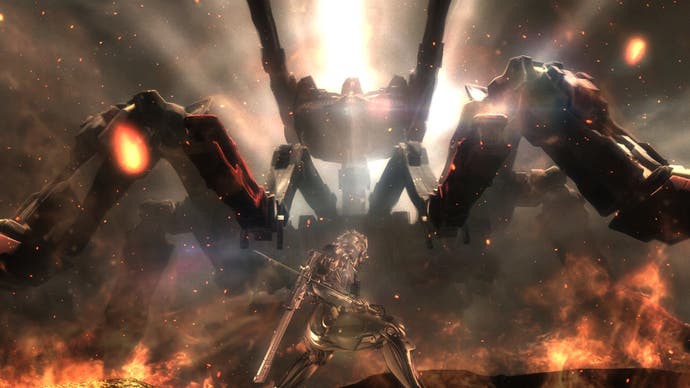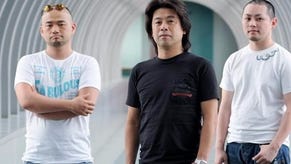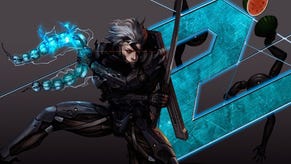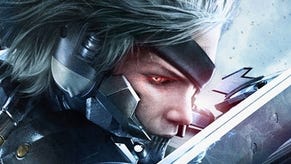Metal Gear Rising: Revengeance review
Shear class.
After recovering from the last boss of Metal Gear Rising: Revengeance, you may need a cold shower. Yet as the credits roll the elation acquires a funereal tinge, a sadness that action movies have just been superseded. Revengeance is the future of high-octane entertainment, a game that blasts out of the gate and simply doesn't stop until the final strike hits home - though there's plenty of slow-mo along the way.
Revengeance is a Metal Gear offshoot in the form of a fighting game, by Osaka's Platinum Games, that tries to muscle in on the turf of Devil May Cry, Ninja Gaiden and Platinum's own Bayonetta. The combat system is defined by two big decisions. The first is that blocking and parrying are handled by the same timed button press and directional input - rather than, as is more usual, being separate tools. The quality of your timing dictates our hero Raiden's defence; go too early and he'll block the attack with no advantage, hit it just as the attack lands and he'll parry into a devastating counterblow that leaves most enemies wide open.
The parry may sound similar to that in other games, but none has ever made staying aggressive so fundamentally important to combat's flow. It is a design choice with a message: in Revengeance, you find a way to keep Raiden on permanent offence, or you die.
The second innovation is what Revengeance terms, with typical understatement, the Zandatsu. This is a specific aspect of the slow-motion Blade Mode and whoever invented it is a genius. Raiden can cut weakened enemies in specific places, then yank out their dripping android spines and crush them. Nice. Severely weakened or just-parried foes bring up a button prompt and, after pressing it, Raiden executes a few quick-fire moves before launching himself (and often the hapless baddie) into the air. Things then go into slow motion at crazy upside-down angles and you have a few seconds to line up a slice over highlighted points. Striking true brings up another prompt to seize the spine and get back to fighting. It is an unbelievable spectacle.

Some may think the Zandatsu strays too close to "quick-time event" territory, but I don't like QTEs and absolutely adore this. Most crucially, it's difficult to slice accurately under pressure and a clumsy first strike sends bits flying off everywhere. The final touch that makes things click is that a Zandatsu refills Raiden's health and energy. There's no pulling out menus to use Vital Stars in Revengeance, just get a parry right and reap some poor body's spinal cord. The parries and Zandatsus intertwine beautifully, making Raiden a fighter who is not only defined by aggression but kept in peak condition by especial brutality.
Raiden has been a magnificent character from his first appearance in Metal Gear Solid 2, but Revengeance reinvents him as a playable hero and in the process creates an avatar that will surely be as defining for Metal Gear's future as Solid Snake once was. There is a trophy for clearing the game with full S ranks on maximum difficulty ('Revengeance', natch) that includes the words 'Lightning God'; there couldn't be a better description. A razor-edged dervish that moves like wind and hits like thunder, Raiden's endlessly intricate movements are matched only by their speed. He positively cracks across the screen, a devastating and irresistible force.
Raiden's main weapon is a katana-like electric blade, tied to the quick attack button for its speed and parries, which can be used with later side-weapons: a crowd-controlling bo-staff that doubles up as a whip, a sai that can shock enemies and pull towards them, or a pair of shears that can also form a gigantic machete. Each combination has its own style, but learning their moves is much less difficult than learning how to use them. Left unchecked, Raiden is basically a superpower, capable of demolishing anything with fabulous, hard-hitting moves.
So Revengeance's challenge is all about keeping him there - and it makes the fights incredible. To play Revengeance is to face a merciless onslaught of enemies that press individually and work terrifyingly well in packs. More so than any of Platinum's previous work, Revengeance owes a huge debt to the precision and ruthless aggression of Ninja Gaiden's opponents but - depending on difficulty of course - it eventually exceeds even that level of brutality. Incoming attacks are constant, from up close and range, with any one foe capable of destroying a casual defence. They'll happily attack from off-screen, too, so you have to be quick on audio as well as visual cues.
The staple grunts are cybernetically enhanced humans equipped with stun-sticks, swords, riot shields, rifles and rocket launchers. The sword-wielding variety is a particular delight to fight, capable of counter-parrying and drawing Raiden into a blink-first mini-duel in the midst of a storm. Facing more than one is a serious task, as they'll always exploit multiple angles and co-ordinate attacks to make clear-headed parries more difficult; as soon as you take one hit in Revengeance, however slight, it takes an instant mental reset to avoid going off-balance with the timing. There's an intensity to this up-close group combat, hugely enhanced by the clever use of slowdown effects, that few fighting games have ever approached.
The frontline soldiers are soon joined by a very Metal Gear cast of biomorphic mechs and cyborgs. Metal Gear Solid 4's mooing Gekkos kick like cranes and charge like bulls, while vicious gorilla-aping androids merrily pound Raiden into the dirt with unblockable grabs (by this point he's learned 'defensive offence', a dodge that naturally inflicts a cheeky hit on the grasping foe). These enemies are relentless because they have to be, and can easily tip into overwhelming - even the most quicksilver of defences can't block three attacks and a throw attempt at once. Multiple unanswered hits will stun Raiden, guaranteeing several more, and entire health bars can disappear in a blink. There's absolutely no ceremony about it: these opponents try to get Raiden in a corner and batter him.
Every battle in Revengeance feels different, not just because of the mix of enemy types and waves but because they can go so many wildly different ways. Hit that first parry bang-on and you may well slice through everything without missing a beat, flowing from counter to devastating counter and getting it over in seconds. Mess it up and take a boot to the head, and the next thing you know Raiden's on the floor, being pummelled and tossed around like a ragdoll by things four times his size. Get it somewhere in the middle, which is what usually happens, and it's a nail-biter.
Revengeance has a nice Metal Gear inheritance that ties into certain battles: the cardboard box. Most fights are inevitable but some begin with the enemies unaware of Raiden's presence. Using the patented Snake shuffle can allow you to sneak up behind them for a silent instant-kill. The fights where you have the sneaking option are definitely some of the toughest, so it's also a nice way of levelling them out a little. And let's not forget that the cardboard box has always been pretty funny and, in these absurd environments surrounded by killer robots, it is even more so.
There has been some negative talk about Revengeance's length. My first play-through was on hard and clocked in at nine hours, the second on very hard at about the same. What is important beyond numbers is that there's no flab - every single level is long, varied and earns its place. There are incredible settings, like a traditional Japanese garden at the top of a skyscraper, and just as many amazing set-pieces. On the very first level, Raiden moves from rocket-jumping to sprinting down a crumbling church, with a perspective-changing shift like no other, before splitting a gigantic Metal Gear in half - and that's not even the climax. Of the first level.

The one area where the game falls down is the camera, which is often troublesome and sometimes outright spoils fights. It has serious issues when Raiden's very close to walls and, given that this is where certain enemies are trying to corner you, it's a pronounced problem. All fighting games have this to some degree, but what makes it infuriating in Revengeance is that parrying is dependent on a directional movement as well as the timed button press - so if you're about to parry a move next to a wall, and the camera suddenly shifts to put the enemy at another angle, good luck.
This is a great shame that becomes even more of a problem on the game's highest difficulty, and the fact that the rest of Revengeance is so good doesn't excuse it. It is no small tribute that Revengeance is essential despite this, but a little of its lustre is lost.
If Revengeance didn't have camera issues this would be the easiest 10 I've ever given. As things stand it's still brilliant, staking out new territory in the genre and adapting certain Metal Gear characteristics so well that it makes the competition look outrageously bad. This is simply the ultimate one-man show, worth its ticket price many times over, an experience that improves exponentially as it gets faster and as you get better. Metal Gear Rising: Revengeance is a thrilling and almost flawless fighting game - come get some.

















